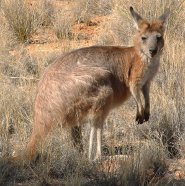 The Hill wallaroo (Macropus robustus), also known as the Common wallaroo or Hill kangaroo, also is a small, stocky marsupial found throughout mainland Australia. Indeed it could be considered rather much the "hobbit" of the kangaroo family in physical terms. Sexual dimorphism is pronounced in this species, the male being almost twice the size of the female. A male Hill wallaroo typically weighs about 30 kilos or 65 lbs, and may be up to 140 centimeters or over 4 feet in length. His female counterpart will average about 16 kilos or 35 lbs in weight, and can grow up to about 3 feet in length. Unlike better known cousins, such as the Eastern Grey Kangaroo, the Hill wallaroo is primarily solitary and nocturnal. The color of the pelt varies from ruddy brown to a very dark shade of grey, approaching black. Unlike other kangaroos which favor open plains country, the Hill wallaroo's favored abodes are rocky hills and cairns, over which it can skip with great agility, utilizing abundant ledges and caves for both shade and protection from predation.
The Hill wallaroo (Macropus robustus), also known as the Common wallaroo or Hill kangaroo, also is a small, stocky marsupial found throughout mainland Australia. Indeed it could be considered rather much the "hobbit" of the kangaroo family in physical terms. Sexual dimorphism is pronounced in this species, the male being almost twice the size of the female. A male Hill wallaroo typically weighs about 30 kilos or 65 lbs, and may be up to 140 centimeters or over 4 feet in length. His female counterpart will average about 16 kilos or 35 lbs in weight, and can grow up to about 3 feet in length. Unlike better known cousins, such as the Eastern Grey Kangaroo, the Hill wallaroo is primarily solitary and nocturnal. The color of the pelt varies from ruddy brown to a very dark shade of grey, approaching black. Unlike other kangaroos which favor open plains country, the Hill wallaroo's favored abodes are rocky hills and cairns, over which it can skip with great agility, utilizing abundant ledges and caves for both shade and protection from predation. Macropus robustus is well adapted to the desert continent it inhabits, being able to derive much of its water from vegetable sources and able to go as long as 90 days without imbibing a drop.
Picture of the hill wallaroo by Michael Barritt & Karen May, licensed under Creative Commons Attribution-Share Alike 2.0 Generic license.
The Common wallaroo, hill wallaroo is listed as Least Concern (LR/lc), lowest risk. Does not qualify for a more at risk category. Widespread and abundant taxa are included in this category, on the IUCN Red List of Threatened Species
Countries
AustraliaSome facts about the
Wallaroo
Adult weight : 30 kg (66 lbs)
Maximum longevity : 22 years
Female maturity :547 days
Male maturity : 670 days
Gestation : 32 days
Weaning : 351 days
Litter size : 1
Interval between litters : 264 days
Weight at birth : 0.001 kg (0.0022 lbs)
Weight at weaning : 2.5 kg (5.5 lbs)
Basal metabolic rate : 33 W
Body mass : 29.648 kg (65.2256 lbs)
Temperature : 35.85 °C (96.53 °F)

Custom Search